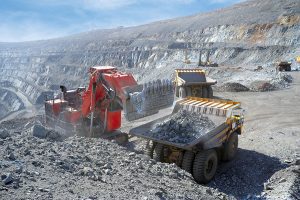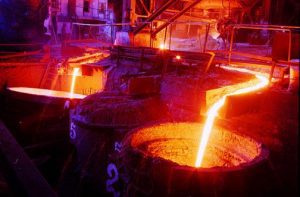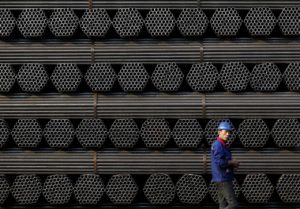
Ukraine in January-February of this year reduced exports of titanium-containing ores and concentrate in quantity terms by 39.5% compared to the same period last year, to 74,694 tonnes.
According to statistics released by the State Customs Service on Tuesday, in monetary terms, exports of titanium-containing ores and concentrate decreased by 19.3%, to $22.109 million.
At the same time, main exports were carried out to China (35.97% of supplies in monetary terms), Turkey (23.48%) and the Czech Republic (12.07%).
During this period, Ukraine imported 100 tonnes of titanium-containing ores from Senegal in the amount of $89,000, while in January-February 2020 it imported from this country 146 tonnes of titanium-containing ores worth $102,000.

PrJSC Zaporizhkoks, one of the largest Ukrainian coke and chemical producers, part of Metinvest Group in January-February this year reduced production by 1.1% compared to the same period last year, to 140,100 tonnes.
According to the company, 66,100 tonnes of blast furnace coke were produced in February, while a month earlier – 74,000 tonnes.
As reported, Zaporizhkoks in 2020 increased production by 3.1% compared to the previous year, to 853,120 tonnes.
Zaporizhkoks produces about 10% of coke produced in Ukraine, owns a full technological cycle of processing coke-chemical products. In addition, it produces coke oven gas and pitch coke.
Metinvest is a vertically integrated group of mining companies. Its main shareholders are SCM Group (71.24%) and Smart-Holding (23.76%), jointly managing the company.
Metinvest Holding LLC is the managing company of Metinvest Group.
CUTS, METINVEST, METINVEST’S COMPANIES, OUTPUT, ZAPORIZHKOKS

Ukrainian metallurgical enterprises in January of this year reduced the production of general rolled products, according to recent data, by 1.2% compared to the same period last year, to 1.659 million tonnes.
According to the report of the Ukrmetalurgprom association on Tuesday, in the first month of the year steel production decreased by 0.1%, to 1.841 million tonnes, while cast iron increased by 5.1%, to 1.817 million tonnes.
As reported, over 2020, Ukrainian metallurgical enterprises increased production of general rolled products by 0.7% compared to 2019, to 18.344 million tonnes, reduced steel by 1.4%, to 20.549 million tonnes and increased cast iron by 1.5%, to 20.358 million tonnes.

The net profit of Alfa-Bank (Kyiv) in 2020 amounted to UAH 1.21 billion, which is 1.6 times less than in 2019 (UAH 1.93 billion).
According to the bank, in the fourth quarter of last year, the bank received UAH 433.645 million of net profit, which is 1.4% less than in the same period in 2019 (some UAH 440 million).
Alfa-Bank’s assets over the past year increased by 35.6%, to UAH 97.5 billion, including the bank’s loan portfolio by 22%, to UAH 47.82 billion, due to loans provided to business entities, the volume of which increased by 51.4% to UAH 19.6 billion. At the same time, the volume of highly liquid assets increased by 39.5%, to UAH 7.2 billion, due to an increase in cash balances by 74.7%, to UAH 5.1 billion.
It is indicated that the balances on the account in the National Bank as of January 1, 2021 amounted to UAH 2.1 billion, while the liabilities to the National Bank reached the level of UAH 9.9 billion.
According to the statistics, the volume of balances placed on correspondent accounts in other banks increased 4.2 times, to UAH 8.3 billion.
The bank’s liabilities increased by 38.5% to UAH 87.8 billion, including the volume of legal entities’ funds by 34.8%, to UAH 30.4 billion, and funds of individuals by 19.4%, to UAH 41.5 billion.
The bank’s capital increased by 18.1%, to UAH 9.7 billion, and the regulatory capital as of January 1, 2021 amounted to UAH 8.8 billion.
As of October 1, 2020, Alfa-Bank ranked sixth in terms of total assets (UAH 101.64 billion) among 74 banks operating in the country.

Ukrainian metal and mining enterprises in January-August 2020 decreased rolled steel output 1.5% year-over-year, to 12.337 million tonnes.
According to the Ukrmetallurgprom association, steel smelting fell by 6.2%, to 13.742 million tonnes, cast iron output by 0.9%, to 13.599 million tonnes.
In August 2020, Ukrainian metal companies produced 1.69 million tonnes of rolled steel, 1.887 million tonnes of steel, and 1.858 million tonnes of cast iron.
As reported, Ukrainian metal and mining enterprises in 2019 cut rolled steel output by 1% year-over-year, to 18.4 million tonnes. Steel smelting fell by 1%, to 20.8 million tonnes, cast iron output by 2%, to 20 million tonnes.

Ukrainian enterprises reduced steel pipe production 4.4% year-on-year in January-September, to 806,700 tonnes.
The country produced 69,300 tonnes of pipes in September, compared with 75,800 tonnes in August, the Ukrtruboprom association told Interfax-Ukraine.
Khartsyzsk Pipe Mill in Donetsk region idled, as it did in 2018.
Interpipe Nyzhniodniprovsky Pipe Rolling Plant reduced output 16.7% year-on-year in January-September, to 182,200 tonnes, including 12,800 tonnes in September, Interpipe Novomoskovsk Pipe Plant produced 86,300 tonnes, up 1.4%, including 9,800 tonnes in September, and Interpipe Niko Tube raised production by 1.45% to 280,600 tonnes, including 19,700 tonnes in September.
Kominmet pipe mill reduced output 12.5%, to 111,600 tonnes in the nine months, including 14,100 tonnes in September, Centravis raised stainless steel pipe production 10.8%, to 15,700 tonnes, including 1,900 tonnes in September, production rose 4.4% to 111,700 tonnes including 9,900 tonnes in September at Illich Iron & Steel Works in Mariupol, it jumped 35.8%, to 16,700 tonnes, including 1,000 tonnes in September, at Dnipropetrovsk Pipe Mill, and fell 9.1% at Trubostal, to 2,000 tonnes, including 200 tonnes in September.
Ukrainian pipe production fell 0.5%, to 848,000 in 2016 but it had risen ever since, growing 5.2% in 2018, to 1.103 million tonnes.